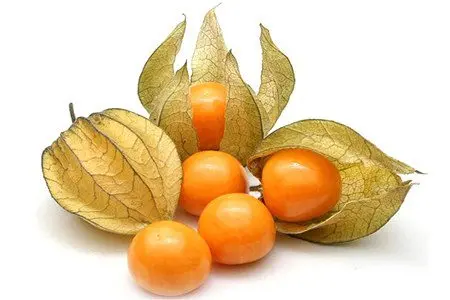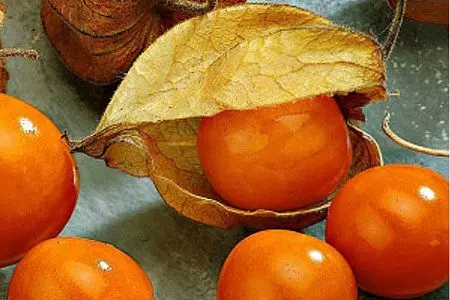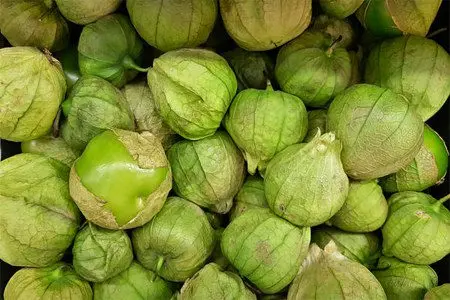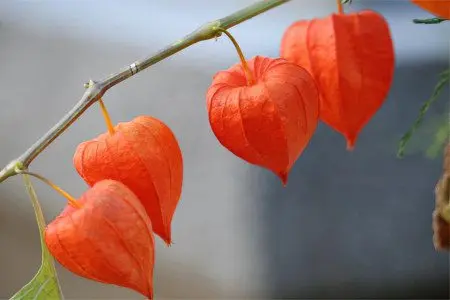Contents
Today, few people know that initially physalis was perceived exclusively as an indoor ornamental plant. In Europe, it was called Chinese or autumn lantern, used for decoration. Thanks to the active study of the composition and properties of plants, scientists managed to reveal physalis from completely new, unknown sides.
What is physalis, what does it taste like?

Physalis is the largest genus of plants in the Solanaceae family, often compared to tomatoes (Solanum lycopersicum). People call it emerald berry or earthy cranberry (although it has nothing to do with cranberries). This plant has a thin and stiff root system, very branched. Under the ground, the creeping rhizome grows rapidly in width. The leaf blade is painted in a light green color, has an oval shape and jagged edges.
In early summer, the plant begins to bloom and small drooping flowers appear on the stems. Flowers – this is perhaps the most unusual in physalis. They appear in leaf axils along the entire height of the stem in July-August. Each of them consists of five lobed petals. Over time, their sepals are interconnected so that a flashlight is formed. The color of the flowers is bright, can vary from orange to red.
The fruits ripen until frost. Physalis fruits are an orange berry, small in size, slightly similar in appearance to an ordinary cherry. The fruit is in an orange-red calyx, which has hairs on its surface.
Physalis grows throughout Russia, as well as in Iraq, the Baltic states and the Caucasus. Most often, this plant is found between shrubs, in the forest and in vegetable gardens.
Physalis is a berry, vegetable or fruit?
The question of whether physalis is a berry, a vegetable or a fruit quite often arises among people who try the product. The fruit can really confuse with its taste.
Strawberry variety is perceived by tasters as a berry, Mexican – as a vegetable. Pineapple and plum varieties, due to their characteristic flavor, resemble fruit. However, from the point of view of biology, physalis is a berry, like a tomato.
Types of Physalis
All varieties of physalis are divided into decorative and food. Vegetable and dessert crops are distinguished among food crops.
Dessert physalis

The fruits of dessert physalis are distinguished by a wide variety of tastes. All varieties are superior to vegetables in the content of sugars, which can reach 15%. In stores, as a rule, dessert is sold. It tastes like delicious berries, hence it is also called berry or strawberry physalis.
The berries are small, as a rule, their weight does not exceed 3 grams. There are varieties whose fruits reach a weight of up to 9 grams. Depending on the variety, strawberry, grape or pineapple notes are present in the taste of dessert physalis. The fruits can be consumed raw or processed. Fresh dessert physalis can be stored in the refrigerator for about six months.
Dessert physalis is less resistant to adverse climatic conditions. Fruit ripening occurs much later than vegetable varieties.
Physalis vegetable

Varieties of vegetable physalis are thermophilic and die after frost. At the same time, they are completely undemanding to the type of soil.
The cases of vegetable physalis are yellowish-green, sometimes with a lilac tint. The berries of vegetable varieties are very large, reaching 5-7 cm in diameter, and the weight of one can be from 20 to 150 grams. Outwardly, they look like tomatoes. The pulp of the fruit is juicy, fleshy, contains many tiny seeds. Usually the taste of vegetable physalis is sweet and sour, which largely depends on external conditions. Sunny, dry and warm summers provide an incredible taste of golden berries, which are pickled for the winter, used to make sauces.
Decorative Physalis

Decorative physalis is popular among florists and landscape designers. Its branches are literally strewn with bright red lanterns that stand out from other plants. It propagates by rhizome and quickly occupies free spaces in the garden. Decorative varieties are highly frost-resistant and able to withstand temperatures down to -30°C.
The branches of decorative physalis are cut in September, placed to dry in a dark place and used to decorate floral arrangements.
Decorative physalis is unsuitable for human consumption and can even cause poisoning.
[Video] Strawberry physalis – delicacy and medicine:









